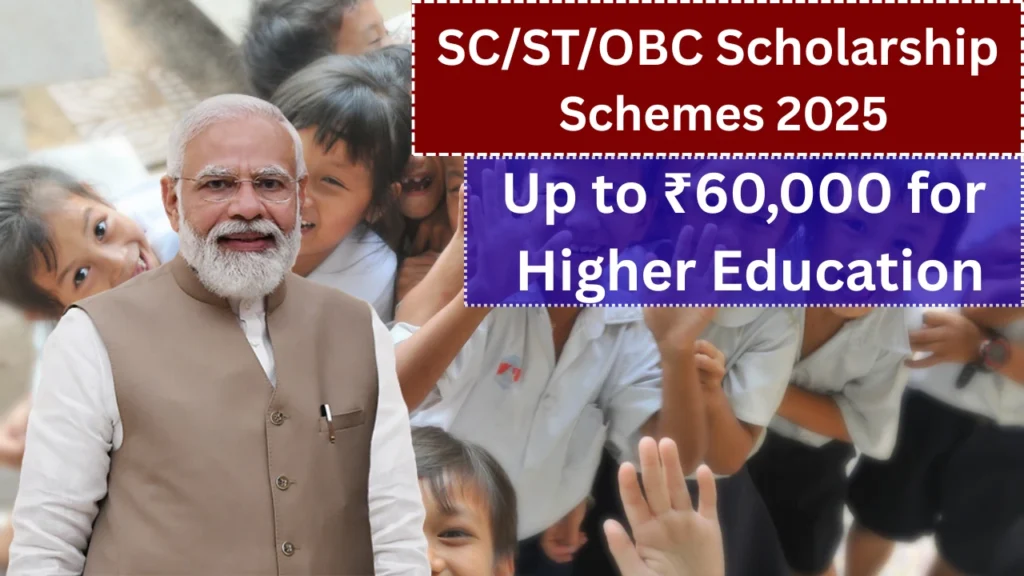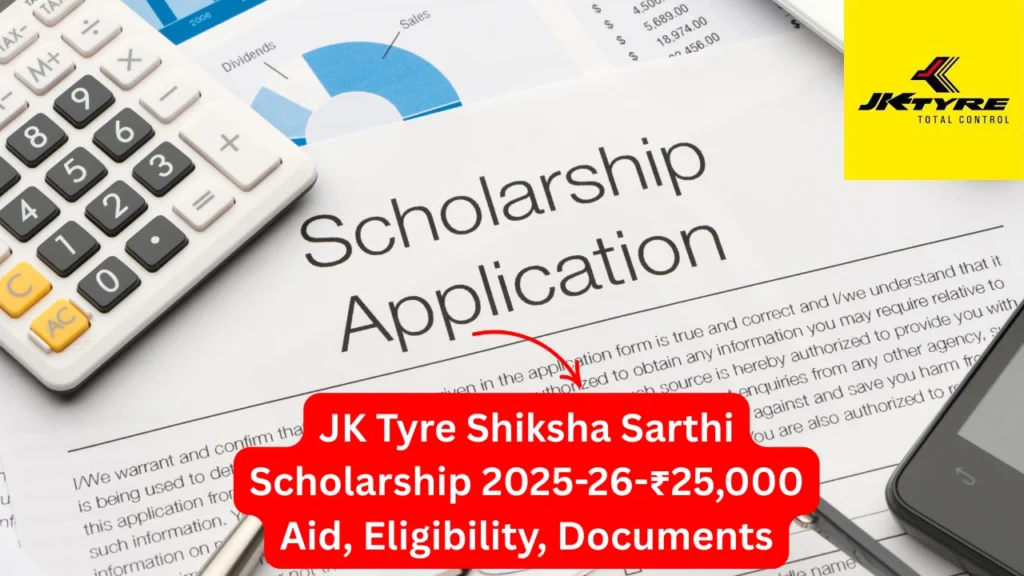Access to higher education remains vital for social mobility in India. The SC/ST/OBC Scholarship Schemes 2025 address financial obstacles faced by students from underrepresented communities. Two major programmes offer either ₹60,000 or ₹48,000 annually, depending on the scheme. Funds cover tuition, living costs, books and, in the ₹60,000 scheme, hostel fees. This article explores scheme details, eligibility, application procedures, state variations, benefits, and practical advice to secure funding.
SC/ST/OBC Scholarship Schemes 2025
| Maximum Annual Award | ₹60,000 (includes hostel allowance) ₹48,000 (maintenance only) |
| Eligible Categories | Scheduled Castes, Scheduled Tribes, Other Backward Classes |
| Income Ceiling | ₹2.5 lakh per annum (₹3.5 lakh in some states for ₹48,000 scheme) |
| Academic Level | Post-matric (Class 11 onwards), including professional and master’s |
| Disbursement Mode | Direct Benefit Transfer to Aadhaar-linked bank account |
| Application Platform | National Scholarship Portal and state portals |
| Annual Deadlines | Vary by state (typically July–September 2025) |
| Key Documents | Caste & income certificates, mark sheets, Aadhaar, bank details |
| Total Beneficiaries (Est.) | Up to 500,000 students nationwide |

2. Historical Context and Objectives
Constitutional safeguards promote education among SC, ST and OBC communities. Since inception, post-matric scholarship schemes have expanded funding and reach:
- 1980s–2000s: Initial grants focused on covering tuition fees.
- 2010s: Maintenance allowances introduced to support living expenses.
- 2025 Update: Maximum awards increased to ₹60,000 (versus prior ₹45,000) for select schemes.
Primary aims:
- Reduce Dropout Rates
Financial aid keeps students enrolled through higher secondary and beyond. - Encourage Professional Courses
Merit-cum-means and top-class scholarships target technical degrees and postgraduate research. - Promote Equity
Ensures students from disadvantaged backgrounds access quality institutions without undue debt.
3. Key Features of the 2025 Schemes
| Feature | ₹60,000 Scheme | ₹48,000 Scheme |
|---|---|---|
| Total Annual Support | Up to ₹60,000 | Up to ₹48,000 |
| Coverage | Tuition + Maintenance + Hostel | Maintenance only (₹4,000/month) |
| Academic Scope | Class 11 to PG and professional degrees | Class 11 to PG and professional degrees |
| Disbursement Frequency | Quarterly | Monthly |
| Institution Recognition | UGC/AICTE/AISHE approved | UGC/AICTE/AISHE approved |
| Special Allowances | Books, stationery, equipment | Books and stationery |
Both schemes deliver funds via Direct Benefit Transfer (DBT) to ensure transparency. Aadhaar linking and bank account verification remain mandatory.
4. Eligibility Criteria
Applicants must meet all criteria:
- Community
SC, ST or OBC status backed by a valid caste certificate. - Income
Family income ≤ ₹2.5 lakh/year (₹3.5 lakh for ₹48,000 scheme in some states). - Academic Level
Enrolled in post-matric studies (Class 11 onwards), including bachelor’s, master’s, professional and research programmes. - Academic Performance
Minimum passing grade in prior qualifying exam; many postgraduate schemes require ≥ 60 %. - Age Limit
Generally < 30 years; specific fellowships (M.Phil/PhD) may allow older applicants. - Exclusivity
No concurrent receipt of other central post-matric scholarships for the same course.
5. Application Process
5.1 National Scholarship Portal (NSP)
- One-Time Registration
Create an NSP profile using Aadhaar, email and mobile number. - Scheme Selection
Choose the correct scholarship (₹60,000 or ₹48,000). - Form Completion
Provide personal, academic and bank details. - Document Upload
Caste & income certificates, mark sheets, Aadhaar, bonafide certificate. - Submission & Printout
Submit online and retain printout for institute verification.
5.2 State-Specific Portals
States like West Bengal (OASIS), Delhi (E-District), Gujarat (Digital Gujarat) and others run parallel systems. Students follow similar steps on the relevant portal, noting unique document or deadline requirements.
6. State Variations in Deadlines and Rules
| State | Portal & Deadline | Income Ceiling | Additional Notes |
|---|---|---|---|
| West Bengal | OASIS – Aug 2025 | ₹2.5 lakh | No hostel fee component in ₹48K scheme |
| Delhi | E-District – May 2026 | ₹2.5 lakh | Additional merit requirement for postgraduate |
| Gujarat | Digital Gujarat – Sep 2025 | ₹2.5 lakh | Requires AISHE code for colleges |
| Karnataka | SSP & NSP – Nov 2025 | ₹2.5 lakh (OBC ₹1 lakh in state) | OBC category demands ≥ 60 % marks |
| Odisha | Odisha Scholarship – Jul 31 2025 | ₹2.5 lakh | Panchayat endorsement for rural applicants |
| Maharashtra | MahaDBT – Mar 2026 | ₹1.5 lakh (OBC) | CAP rounds for professional courses |
| Uttar Pradesh | UP Scholarship – TBD | ₹2.5 lakh | Bonafide certificate mandatory |
| Rajasthan | SJE Rajasthan – TBD | ₹2.5 lakh | Dedicated helpline for queries |
State portals may impose family caps (e.g., Assam limits two sons per family) or extra female-student quotas to promote gender balance.
7. Document Checklist
- Mandatory
Aadhaar card, caste & income certificates, previous year’s mark sheet, bonafide/attendance certificate, bank account passbook. - Optional/State-Specific
UDISE code (for school-based schemes), PAN card, rural domicile certificate, disability certificate for PWDs, photographs as specified.
Missing or mismatched documents often cause application defects. Early preparation helps avoid rejections.
8. Disbursement and Monitoring
- DBT to Bank Account
Scholarships credited directly; quarterly for ₹60K scheme, monthly for ₹48K. - Status Tracking
NSP dashboard shows application stage—submitted, verified, sanctioned, disbursed. - Institute Verification
Colleges confirm enrollment and attendance before each tranche.
Prompt monitoring ensures timely receipt. Discrepancies escalate via NSP grievance interface or state helplines.
9. Impact and Benefits
- Financial Relief
Eliminates tuition and living-cost barriers. - Enhanced Enrollment
Uptick in SC/ST/OBC students in higher education—particularly professional courses. - Social Mobility
Degree holders secure better jobs, lifting families out of poverty. - Gender Equity
Reserved quotas for female students boost women’s participation. - Research Advancement
Fellowships for M.Phil/PhD under OBC National Fellowships strengthen academic output.
Surveys show scholarship recipients have higher retention and completion rates, validating programme effectiveness.
10. Challenges and Remedies
| Challenge | Suggested Solution |
|---|---|
| Late or fragmented state notifications | Unified NSP alerts with SMS reminders |
| Document mismatches | Pre-validation camps at colleges and CSCs |
| DBT delays | Real-time tracking and bank coordination |
| Low awareness in rural areas | Outreach via village panchayats and local NGOs |
| Limited access to internet | Mobile registration units and CSC kiosks |
Continuous feedback loops between DSEL, state agencies and student bodies help refine processes.
11. Expert Tips for Applicants
- Start Early: Register as soon as the portal opens—before peak traffic.
- Document Audit: Cross-check certificates against official guidelines.
- Maintain Grades: Aim for ≥ 60 % to qualify for postgraduate and merit-based awards.
- Use CSC Services: Certified Common Service Centres can assist for ₹30 per application.
- Follow up: Track status weekly and escalate issues within NSP grievance redressal.
These steps improve chances of smooth approval and timely crediting.
12. Future Directions
- Unified App: Proposed mobile app integrating NSP and state portals for single-click applications.
- Indexed Awards: Linking scholarship amounts to inflation or CPI to preserve real value.
- Coaching Support: Free test-prep classes for competitive exams under future schemes.
- Enhanced Data Analytics: Using AI to predict dropout risk and allocate additional counselling resources.
Such innovations aim to keep India’s social justice schemes responsive and student-centric.
Frequently Asked Questions
Students belonging to SC, ST or OBC categories, with family income up to ₹2.5 lakh (₹3.5 lakh for some ₹48K schemes), enrolled in post-matric studies.
The ₹60 K award covers tuition, maintenance and hostel; disbursed quarterly. The ₹48 K scheme provides a ₹4 K monthly maintenance allowance.
Register on the National Scholarship Portal or your state’s portal, submit documents online, then monitor status via the dashboard until DBT credit appears.
Yes, through NSP and state portals. Deadlines and income ceilings vary, so check your state’s guidelines early.
Yes. Renewal requires fresh submission of updated academic and income documents before the annual deadline.
The SC/ST/OBC Scholarship Schemes 2025 represent a critical step toward inclusive higher education in India. By offering up to ₹60,000 or ₹48,000 per annum, these programmes ease financial burdens, enhance retention and empower students from disadvantaged backgrounds. Clear eligibility rules, robust application platforms, state-level adaptations and direct benefit transfers underpin their success. Applicants who prepare documents early, monitor their applications and leverage support channels maximise their chances. As India advances toward universal access to quality education, these scholarships remain central to social equity and national development.
Click here to learn more

John Michael Ramos is a blogger passionate about Government Schemes, Exams, Automobiles, and Trending News. His aim is to provide simple and authentic information.

